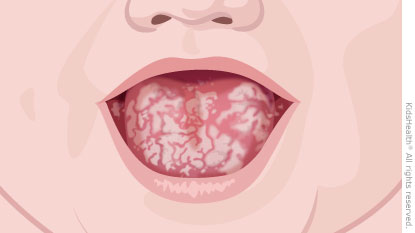Thrush is an infection in the mouth caused by a type of germ called Candida albicans. Babies with thrush have white patches in their mouth. The patches may cause discomfort and make the baby not want to suck or eat.
In healthy babies who are feeding well, health care providers may wait to see if the thrush goes away on its own. If needed, there is medicine that can treat thrush.
Here's how to care for your baby.



Your baby:

What causes thrush? Candida albicans (the germ that causes thrush) lives in the mouth and doesn't usually cause any problems. But if too much of it grows, it can lead to thrush.
Who gets thrush? Thrush is especially common in babies younger than 6 months old. Older kids who are on antibiotics, who have diabetes, or whose immune systems are weakened by illness or some types of medicines also can get it.
Is thrush contagious? Thrush isn't usually contagious, although a breastfeeding mother whose infant has thrush may get a yeast infection around her nipple that causes redness and soreness.